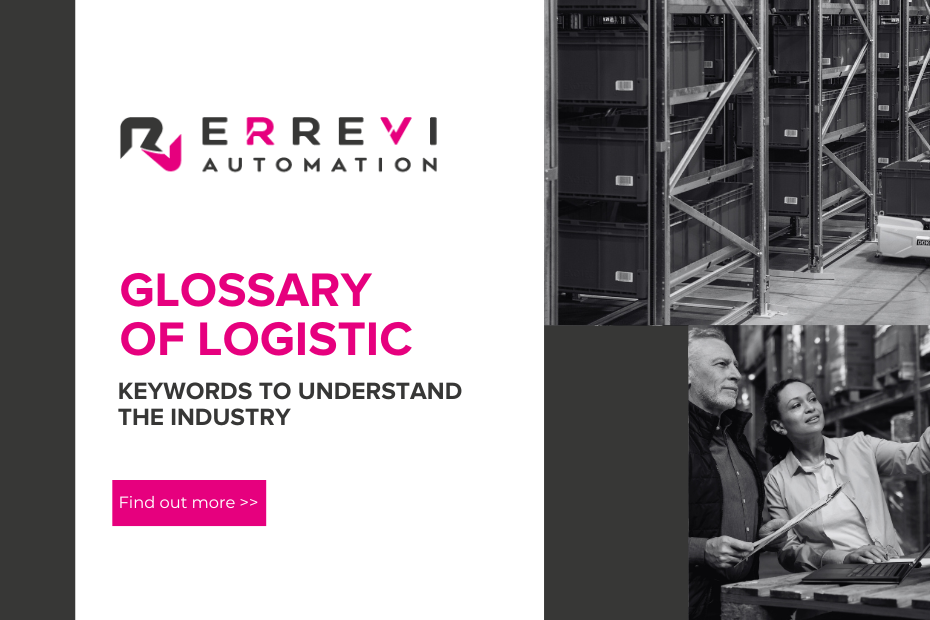Introduction
Thelogistics automation is radically transforming the way warehouses
manage their day-to-day operations. With the advent of advanced technologies such as
robotics, artificial intelligence and IoT (Internet of Things), warehouses are becoming
increasingly efficient, precise and fast handling of goods. However, navigating through the maze of terminologies and concepts related to automation, warehousing and logistics can be daunting. In this article, we will explore a essential glossary of thelogistics automation to help you better understand this fast-moving world
evolution.
In this article:
Key terms in logistics
It is a physical structure or dedicated space where goods, merchandise or articles used in a logistics operation are stored, managed and organised. Logistics is a discipline that deals with planning,
of organising and controlling the flow of materials, goods and information in a way that
efficient and economic, from point of origin to point of destination, in order to
meet customers' needs.
The WMS is software that provides access to and visibility of data on the entire inventory of goods and manages the order fulfilment operations of the supply chain. The WMS integrates with the company's ERP system, which manages the administrative side, and with any other software that manages warehousing and automation.
A warehouse control system (WCS) is software designed to efficiently manage and control operations within an automated or semi-automated warehouse. Its main objective is to coordinate and optimise activities within the warehouse in order to maximise operational efficiency, reduce errors, increase the accuracy of operations and improve the visibility of ongoing activities.
Automated picking involves the use of robots or mechanised systems to pick products from the shelves and prepare them for dispatch. This reduces human errors and speeds up the order preparation process.
A sorter is a mechanised system that separates and routes products to different destinations based on criteria such as destination, size or weight. It is used in particular in distribution centres to sort large quantities of goods efficiently.
The self-driving vehicles are used to transport goods, packages, crates or pallets, within a warehouse or production area, following predefined routes.
These are autonomous shuttles that move around a plant using a series of sensors, artificial intelligence and machine learning to plan routes without human intervention. AMRs are equipped with cameras and sensors, which detect obstacles and are able to prevent collisions, slow down, stop or divert the route around things or people.
A system of illuminated signs placed on shelves or containers to guide workers through the picking process precisely and efficiently.
This is a picking system used in warehouse or distribution environments to speed up the order preparation process and reduce errors. This system involves the use of bright lights and displays placed at different storage or work points, such as shelves, carts or workbenches. The bright lights provide clear visual guidance to operators, showing them exactly where to place items, thus simplifying the process of picking and packing orders.
Practical logistics in which received goods are transferred directly from one side of the warehouse to the other without being stored, reducing storage time and improving delivery speed
These are mechanical conveyors for moving products from one point to another within the warehouse. Conveyor systems can be roller, belt or chain conveyors depending on the type of unit to be handled (packages, totes or pallets).
Load unit or CU defines thebasic storage or transport units for a specific warehouse. UdCs usually refer to Single Package (first level), Pallet and similar supports (second level) and Container, swap body and semi-trailer (third level), used to handle them. The type of UDC varies according to the size and characteristics of the goods.
Material management method based on the concept of containers, understood as units of
measure, which must be refilled when they are emptied. The term is Japanese and means 'tag', whereby, each time an action is finished, a kanban is handed over to the previous sector to let them know that it is finished and that a new piece can be sent.
Ready to rely on us for your warehouse management?
These terms are fundamental to understanding how the warehouses
automated and how they can improve the efficiency, accuracy and speed of warehouse. The continuous evolution of technology will continue to bring new innovations to the warehouse logisticsa sector that is constantly growing. Errevi Automation continuously invests in technology, research and development and makes all the know-how available to customers to offer up-to-date and advanced solutions di automated warehouse.
Contact our Sales Team and tell us about your automated warehouse project, together we will find the best solution to achieve your goals!
Recent articles from the Errevi Automation Blog

Warehouse management: what factors to consider?
Nella supply chain l’efficientamento dei processi e delle risorse contribuisce ad aumento della produttività e ad un riduzione degli sprechi. È fondamentale dunque capire quali

Industrial Shelving: A Guide to Choosing the Optimal Solution for Your Automated Warehouse
L’efficienza di un magazzino dipende da diversi fattori. Uno tra questi fa riferimento alle modalità tramite cui si sceglie di organizzare e ottimizzare lo spazio

The future of warehouse logistics: how Industry 5.0 is transforming automation
Nel mondo sempre più competitivo della logistica di magazzino, l’evoluzione è una costante inevitabile. L’era dell’Industria 4.0 ha portato con sé una rivoluzione nell’automazione, ottimizzando
